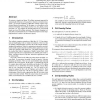12 search results - page 2 / 3 » Physically Based, Self-Organizing Cellular Automata |
VR
2003
IEEE
13 years 10 months ago
2003
IEEE
We present a simple and linear 3D cellular automata approach for animating the behaviors of viscous flow volumes in virtual environments. An accurate modeling of fluid flow usu...
ICS
2010
Tsinghua U.
14 years 2 months ago
2010
Tsinghua U.
Computation in the physical world is restricted by the following spatial locality constraint: In a single unit of time, information can only travel a bounded distance in space. A ...
DIGITEL
2007
IEEE
13 years 11 months ago
2007
IEEE
Distributed Computational Toys are physical artifacts that function based on the coordination of more than one computing device. Often, these toys take the form of a microcontroll...
ACRI
2004
Springer
13 years 10 months ago
2004
Springer
Modeling free-form shapes in 3D spaces based on strict physical laws require a considerable amount of computation time. Previous experiences with Cellular Automata demonstrated sub...
WADS
2007
Springer
13 years 11 months ago
2007
Springer
In the maximum sharing problem (MS), we want to compute a set of (non-simple) paths in an undirected bipartite graph covering as many nodes as possible of the first layer of the ...

